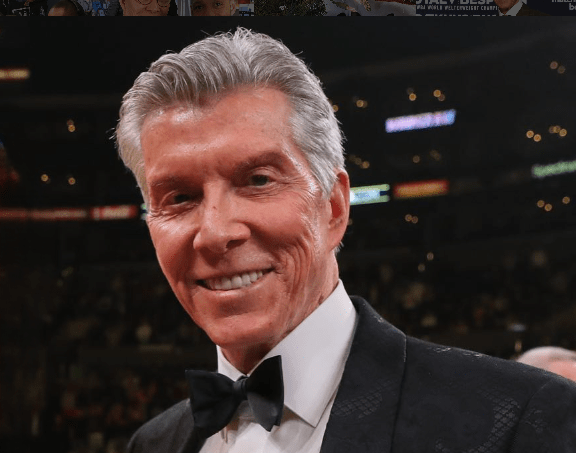One of the most strikingly successful financial success stories in entertainment history may be Michael Buffer’s pay plan. His catchphrase, which rocked arenas and made him a legend, served as the foundation for his income empire, which he started with no official connection to boxing. In the early 1980s, when professional boxing was experiencing a revival, he redesigned the ring announcer role, starting his journey from relatively unknown announcer to voice-brand billionaire.

Buffer’s tendency toward showmanship not only gave combat sports a ceremonial element, but also quietly turned the job into performance art. Audiences immediately admired the theatrical flair he brought to the ring with his elegant tuxedos, fluid delivery, and forceful pauses. But nothing really changed until he came up with his famous phrase, “Let’s get ready to rumble!” then. That term didn’t simply catch on; it spread like wildfire throughout advertising, video games, pop culture, and sports.
Michael Buffer – Bio and Career Summary
| Category | Details |
|---|---|
| Full Name | Michael Buffer |
| Date of Birth | November 2, 1944 |
| Age | 80 |
| Place of Birth | Philadelphia, Pennsylvania, USA |
| Profession | Boxing and Wrestling Ring Announcer, Entrepreneur |
| Catchphrase | “Let’s get ready to rumble!” |
| Net Worth | Estimated $400 million |
| Active Since | 1982 |
| Major Earnings Source | Licensing, Announcing, Trademark Royalties |
| Event Fee Range | $25,000 to $100,000; up to $1 million for special events |
| Relatives | Bruce Buffer (Half-Brother, UFC Announcer) |
| Children | 2 Sons |
| Current Residence | Southern California |
| Website | www.letsrumble.com |
Surprisingly, Michael Buffer decided to trademark the phrase in 1992, which greatly boosted his long-term profits. Inspired by NBA coach Pat Riley’s signature “threepeat,” Buffer and his half-brother Bruce realized that intellectual property protection had unrealized commercial potential. Soon, one of his main revenue streams was licensing rights. Since then, Michael has made hundreds of millions of dollars by allowing the phrase to be used in video games, advertising, sports teams, promotional events, and other media types.
In a particularly profitable move, Buffer reportedly received a $100 million deal for perpetual usage when he licensed the term to Midway Games for the now-iconic video game Ready to Rumble. He surpassed many athletes and entertainers who train or perform in harsh environments for years with that deal alone, putting him in the highest echelons of sports-adjacent earners.
The straightforwardness and audacity of Buffer’s strategy demonstrate how one calculated choice, along with timing and branding, may turn a conventional career into one that is extremely profitable. Although he often charges between $25,000 and $100,000 for appearances at events, he has occasionally received $1 million for a single high-profile event. The cultural effect, anticipation, and intense emotion that build up to a big confrontation are all reflected in these metrics, which go beyond performance.
Buffer has continued to be extremely adaptable outside of the ring. His voice and presence have been included in popular films including Harlem Nights, 2012, and Rocky Balboa, as well as comedy like You Don’t Mess with the Zohan. Additionally, television called with appearances on The Simpsons, The Bold and the Beautiful, and America’s Next Top Model. His public profile was increased by each of these endeavors, which strengthened his iconic stature and enabled him to command higher fees for subsequent engagements.
The influence of Buffer extends far beyond profits. He radically changed the way that people watch combat sports. A cultural audio clue that something important is going to happen is his deep-toned introduction. In many respects, his voice is the spark that ignites the adrenaline that instantaneously awakens millions of people sitting ringside or watching from home. That kind of social effect is extremely uncommon and cannot be easily imitated or repeated by another announcer.
His family history adds even more intrigue. In 1989, Michael and his half-brother Bruce became close after he was reunited with their biological father. They built an empire of cross-sport announcing together. Bruce has established himself as the UFC’s spokesperson, but Michael is the dominant figure in boxing and wrestling. One of the most reputable teams in live event announcing is represented by the Buffer brothers. Their coordination has been exceptionally effective and well-executed, especially with regard to brand licensing and commercial expansion.
Buffer established himself as the standard voice for all boxing bouts advertised in Donald Trump’s casinos during the 1980s and 1990s. The boxing spectacle was produced to almost Hollywood standards during this time, and Mike Tyson was at the height of his career. Buffer’s booming catchphrase solidified his voice as a part of the emotional memory connected to innumerable famous occasions by frequently introducing legendary boxers in arenas that were sold out.
Despite becoming older, Buffer’s demand hasn’t decreased in recent years. He has modified his persona for corporate engagements and internet platforms, demonstrating his continued innovation. He has voiced mobile apps, presented events for luxury brands, and produced e-sports. Buffer’s visionary positioning as a brand ambassador for excitement rather than just a voice is what has allowed him to remain relevant over the years.
Additionally, there is something really wonderful about his perseverance. Any voice-dependent professional’s career may have ended when Buffer was diagnosed with throat cancer in 2008. But after receiving care and recuperating, he came back with astonishingly unaltered strength and clarity. That return showed not just physical healing but also mental resilience, qualities that have been remarkably similar to those of the sportsmen he presents.
The public’s opinion of announcers has also changed as a result of his lengthy career. Ring announcers were mostly supporting characters prior to Buffer. Announcers can now become well-known, make a lot of money, and establish their own brands. He has encouraged others to think beyond the microphone and into business, digital media, and even public speaking, including Bruce Buffer and WWE commentators like Lillian Garcia.
